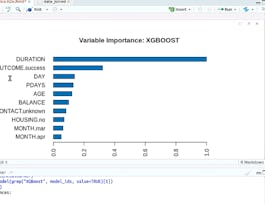Predictive analytics has a longstanding tradition in medicine. Developing better prediction models is a critical step in the pursuit of improved health care: we need these tools to guide our decision-making on preventive measures, and individualized treatments. In order to effectively use and develop these models, we must understand them better. In this course, you will learn how to make accurate prediction tools, and how to assess their validity. First, we will discuss the role of predictive analytics for prevention, diagnosis, and effectiveness. Then, we look at key concepts such as study design, sample size and overfitting.


Population Health: Predictive Analytics
Taught in English
Some content may not be translated
4,999 already enrolled
(23 reviews)
Recommended experience
What you'll learn
Understand the role of predictive analytics for prevention, diagnosis, and effectiveness
Explain key concepts in prediction modelling: appropriate study design, adequate sample size and overfitting
Understand important issues in model development, such as missing data, non-linear relations and model selection
Know about ways to assess model quality through performance measures and validation
Skills you'll gain
Details to know

Add to your LinkedIn profile
16 quizzes
See how employees at top companies are mastering in-demand skills


Earn a career certificate
Add this credential to your LinkedIn profile, resume, or CV
Share it on social media and in your performance review

There are 5 modules in this course
Welcome to the course Predictive Analytics! We are excited to have you in class and look forward to your contributions to the learning community. To begin, we recommend taking a few minutes to explore the course site. Review the material we will cover each week, and preview the assignments you will need to complete in order to pass the course. Click Discussions to see forums where you can discuss the course material with fellow students taking the class. If you have questions about course content, please post them in the forums to get help from others in the course community. For technical problems with the Coursera platform, visit the Learner Help Center. Good luck as you get started, and we hope you enjoy the course!
What's included
2 videos6 readings2 discussion prompts1 plugin
In this module, we discuss the role of predictive analytics for prevention, diagnosis, and effectiveness. We begin with a brief introduction to predictive analytics, which we follow by differentiating between population-based and targeted interventions. We then explain why and when it may be beneficial to test for a diagnosis, and how analytic tools can help inform these decisions. Finally, we focus on the balance between benefits and harms of a certain treatment, and how we can predict the benefit for an individual.
What's included
6 videos6 quizzes
In this module, we will present some key concepts in prediction modeling. First, we weigh the strengths and weakness of various study designs. Second, we stress the importance of an appropriate sample size for reliable inference. Then, we discuss the issues of overfitting a prediction model, and regression-to-the-mean. Finally, we will guide you through the popular bootstrap procedure, showing how it can be used to assess parameter variability.
What's included
6 videos3 readings3 quizzes1 discussion prompt
In this module, we focus on model development. First, we turn our attention to the missing values problem. We discuss well-known missingness mechanisms, and methods to deal with missing values appropriately. Second, we learn about methods to deal with non-linearity in a dataset. We then address the topic of model selection, focusing on the limitations of traditional stepwise selection procedures. Last, we talk about how introducing bias in exchange for lower variance can improve prediction quality. This can be done by using advanced methods, such as LASSO and Ridge regression.
What's included
6 videos4 readings2 quizzes2 discussion prompts
In this final module, we learn about assessing the quality of a prediction model. First, we extensively discuss standard performance measures for both binary and continuous outcomes. Second, we explore different ways of validating a prediction model. We look at how to assess both the internal, and the more relevant external validity of a model. Next, we will look at how to update a model and make it applicable to a specific medical setting. We conclude with an interview, where we more broadly discuss the potential of predictive analytics by taking the example of the island of Aruba.
What's included
6 videos2 readings5 quizzes2 discussion prompts
Instructors


Offered by
Recommended if you're interested in Data Analysis

Columbia University

Coursera Project Network

Yonsei University

Politecnico di Milano
Why people choose Coursera for their career




Learner reviews
Showing 3 of 23
23 reviews
- 5 stars
78.26%
- 4 stars
8.69%
- 3 stars
8.69%
- 2 stars
0%
- 1 star
4.34%
New to Data Analysis? Start here.

Open new doors with Coursera Plus
Unlimited access to 7,000+ world-class courses, hands-on projects, and job-ready certificate programs - all included in your subscription
Advance your career with an online degree
Earn a degree from world-class universities - 100% online
Join over 3,400 global companies that choose Coursera for Business
Upskill your employees to excel in the digital economy
Frequently asked questions
Access to lectures and assignments depends on your type of enrollment. If you take a course in audit mode, you will be able to see most course materials for free. To access graded assignments and to earn a Certificate, you will need to purchase the Certificate experience, during or after your audit. If you don't see the audit option:
The course may not offer an audit option. You can try a Free Trial instead, or apply for Financial Aid.
The course may offer 'Full Course, No Certificate' instead. This option lets you see all course materials, submit required assessments, and get a final grade. This also means that you will not be able to purchase a Certificate experience.
When you purchase a Certificate you get access to all course materials, including graded assignments. Upon completing the course, your electronic Certificate will be added to your Accomplishments page - from there, you can print your Certificate or add it to your LinkedIn profile. If you only want to read and view the course content, you can audit the course for free.
You will be eligible for a full refund until two weeks after your payment date, or (for courses that have just launched) until two weeks after the first session of the course begins, whichever is later. You cannot receive a refund once you’ve earned a Course Certificate, even if you complete the course within the two-week refund period. See our full refund policy.

